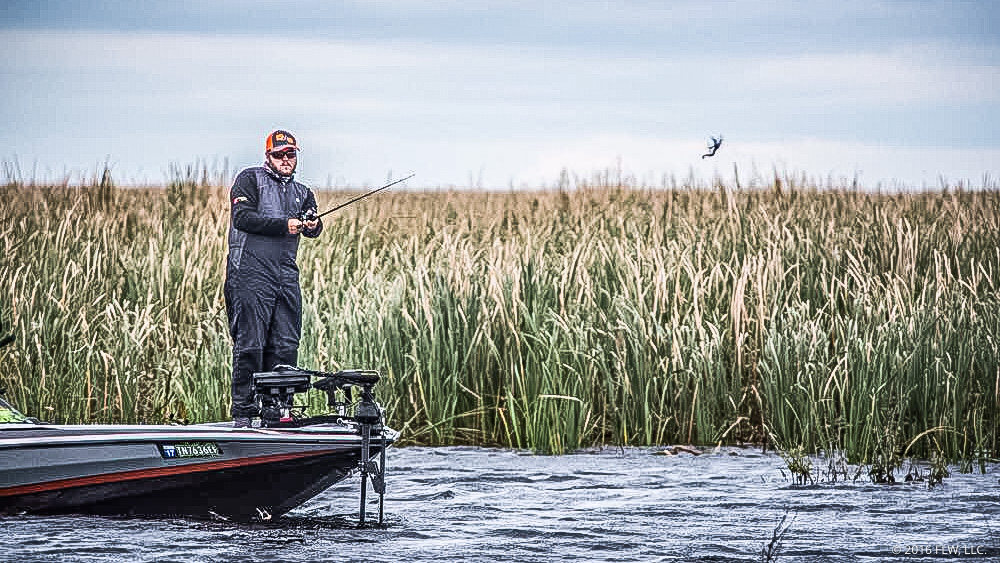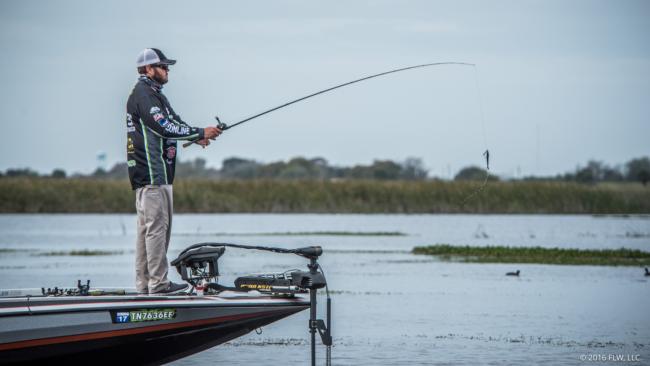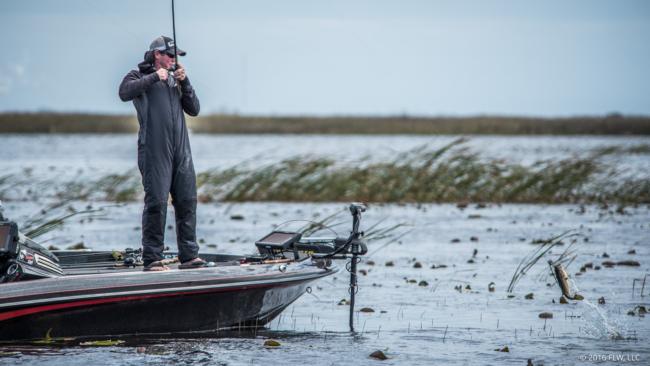The Role of the Swim Jig at Okeechobee
Among casting baits, this one dominated the top 10

Some years at Lake Okeechobee a ChatterBait is the dominant casting lure. Other years it’s a Reaction Innovations Skinny Dipper or similar swimbait.
At the 2016 Walmart FLW Tour opener a few weeks ago, the swim jig was the most popular casting bait throughout the ranks, and it was used at least in part by four of the pros who finished in the top 10.
Those four anglers offered their take on why the swim jig was the better choice for casting and winding this time, and a little more insight into how they used it.
Neal “not a flipper,” needed the efficient swim jig in his area
Tennessee pro Michael Neal expected to be chucking a ChatterBait at Lake Okeechobee, but the fish didn’t cooperate with his plan.
“My dad [Mike Neal] practices with me, and the first day of practice he threw a ChatterBait pretty much all day long and never had a bite,” says Neal, who finished fourth. “I’d just come from Toho [at the Bassmaster Open], and they were biting it up there – not great, but you could catch fish on it. Every other time I’ve been to Okeechobee they were biting it.
“It was really weird. I had every intention of going to Okeechobee and putting the ChatterBait in my hand and not laying it down until the tournament was over. Obviously, that wasn’t the case.”
Neal, who admits he’s “not a flipper,” needed to find a moving bait he could rely on and eventually tied on the swim jig and immediately started getting bit.
“I didn’t catch any big ones on it right away, but I caught a 7-pounder right at dark,” he recalls. “I decided to stick with it. It was a black and blue swim jig, and I had been throwing a green pumpkin ChatterBait, so I thought it was the color. The next day I threw the ChatterBait in black and blue and didn’t get a bite. It wasn’t the color.”
Neal surmises that the odd weather experienced before and during the tournament accounted for the weird reluctance to eat the more erratic ChatterBait. The swim jig, while similar in profile, has a much more subtle action. Of note, he says he’s seen the exact opposite scenario play out, and so he thinks it’s a smart idea to try both throughout a tournament to see if the fish are more turned on to one or the other.
At Okeechobee, Neal also benefited from the weedless nature of the swim jig for the area he was fishing in the mouth of the Kissimmee River.
“I was fishing a lot of arrowhead patches. It’s a plant that sticks out of the water, and the swim jig comes through better,” he says. “There could be two or three clumps to a whole wall of them. They stick up typically 18 inches to 2 feet out of the water. Where I was, there were a lot of clumps scattered out, and I could throw that swim jig right through the middle of them.”
Neal’s approach was to dissect the area thoroughly with the jig. With Power-Poles down, he cast to every piece of cover in an arc of about 180 degrees. Then he picked up his poles, repositioned and repeated the process.
“I generally just use a 3/8-ounce jig, but three-quarters of my fish came on a 1/2-ounce,” he recalls. “I think that with the water being up the fish were lower in the water column than what people were anticipating. I think that 1/2-ounce jig got me a lot more bites. I’d throw it out and slow-roll it. If I felt like I had a little hang-up, I’d snap the rod and get reaction bites that way.”
Neal’s go-to combo was a black-and-blue TrueSouth Custom Lures swim jig with a 4 1/4-inch Big Bite Baits Cane Thumper in the hematoma color.
“Sometimes I’ll throw a single grub or a craw-style trailer, but most of the time I just use a swimbait,” he adds. “That’s one of the more subtle deals. If you use something with a lot of vibration and action with a swim jig, you could be throwing a ChatterBait at the same time.”
McMillan says it’s the swim jig’s turn on Okeechobee
Local pro Brandon McMillan flipped a Texas rig and cast his signature series 4X4 swim jig en route to finishing in sixth place. He says he prefers to fish the north end of the lake – flipping or casting – and that’s where, traditionally, a ChatterBait is a potential tournament-winning lure when fished over hydrilla-covered flats. This season, a couple of extra feet of water in the lake plus a string of cold fronts in the weeks ahead of the tournament washed out the north end.
“With a ChatterBait you pretty much have to be able to pull through hydrilla or deflect off reeds or something like that, and I just don’t think there was much stuff to do that left over at the north shore, Harney Pond area where Jason Lambert won the Costa event [three weeks earlier],” he says. “That’s pretty much your primary section of the lake this time of year that I would consider the prototypical ChatterBait water. I was catching them on it before we went off-limits. It all went away because the water came up.”
McMillan countered by focusing most of his practice and all of his tournament in the “hayfields” and reed heads in the South Bay area. During the warming trend that lasted through practice, he uncovered a red-hot swim jig bite in an area where quality bass were moving up to spawn. He believed he could catch almost 20 pounds a day with it. Unfortunately, the swim jig didn’t meet his expectations in the tournament, leaving McMillan slightly baffled.
“I anticipated catching the majority of my fish on the swim jig,” he says, “but that bite just died for me. I don’t know if it was due to the pressure, but I was really on a good bite. That was my primary deal. I had three of them rigged up in different colors.”
White, black and blue, and a bluegill color were McMillan’s three options. He fished the jig on braided line with a 7-foot, 5-inch G. Loomis casting rod. It still produced for him in the tournament, just not with the quality fish needed to win.
“I try to vary the retrieve to see what they prefer,” McMillan adds. “Most of the time it’s pretty much just a straight reel for down here on Okeechobee. Here you try to reel it and get it down as deep as you can as much as you can, and when it comes across one of the holes where you know there’s a fish on a bed, you kill it.
“If a big group [of spawners] pulls in you can cover so much more water with it,” he continues. “If they’re on the beds it’s pretty much the best bait you can use, in my opinion. That’s why I don’t understand why they got off of it so fast. They were there on beds. I just couldn’t see them.”
According to McMillan, current conditions weren’t the only reason the swim jig was so popular. He says go-to baits on Okeechobee are relatively cyclical, and lately the swim jig has just been the casting bait of choice ahead of swimbaits, bladed jigs, spinnerbaits and the like.
“I think that because our lake fishes so small and there are only two or three really good places on the lake, the fish get accustomed to seeing everything,” McMillan explains. “There’s really no bad time of the year to swim a jig nowadays. That’s kind of taken the place of a lot of things that we used to do down here.”
Weaver couldn’t make topwater work, but deeper swim jig was the ticket
In pre-practice, Tour rookie Joshua Weaver had some success slinging a Reaction Innovations Trixie Shark and Skinny Dipper above the shallow grass and winding both on the surface.
“That was when the water was down,” he says. “With the water up 2 more feet [in the official practice], that was a drastic change for those fish. I thought that it was going to be on fire with a Skinny Dipper or Trixie Shark. Those fish weren’t reacting to them the way they were to the swim jig. I guess they were less aggressive because the water was so high – instead of 2 feet over them it was 4 feet over them. They weren’t wanting to come up and hit that topwater as much as a swim jig coming right over their face.”
Weaver wasn’t necessarily upset that the fish wanted a bait down in the water column. He says the hook-up ratio with a soft plastic on top is significantly lower than with a swim jig, so in a way, the conditions helped him, and he locked up a seventh-place finish.
Interestingly, on day one, Weaver caught almost 60 keepers, including a solid limit snatched up early with a Luhr Jensen Nip-I-Diddee topwater bait. And midday his co-angler had a big blow-up on a toad. He suspected the surface action might be about to turn around. Then a cold front arrived overnight and drastically changed prospects for day two and the rest of the tournament. A north wind pushed more water into his area in South Bay, and 2-foot waves rolled through the hayfields.
The deteriorating conditions solidified the swim jig as the best winding choice, and Weaver mixed it in with flipping presentations.
His casting technique included making repeated drifts with the wind. As he went, Weaver dropped his Power-Poles right after a cast, fished the jig all the way back, then repeated. He drifted and stopped his way across the hayfields and covered a large area, but says the juice was a patch smaller than the size of a football field. He also specifically targeted clusters of lily pads.
“They were spawning on the roots of the lily pads,” he says. “I would fish through all the hay – just hay with no lily pads around it – but I wouldn’t stop and fish it as thoroughly as where there were lily pads,” he explains. “When I wasn’t casting I was flipping at the lily pad roots.
“I felt like the fish were being more sluggish,” he adds. “The lows [water temperatures] were getting low for Florida fish, so I was reeling it slower in the morning. As the day progressed I was speeding up my retrieve.”
Weaver opted for a 3/8-ounce 4X4 Brandon McMillan’s Signature Series Swim Jig in the McMillan’s secret color with a sungill-colored Skinny Dipper on the back.
With vision blocked by dirty water, Johnston realized the swim jig was the better choice
Ontario’s Chris Johnston fished a program similar to that of McMillan and mixed in a swim jig with a flipping presentation in the hayfields and reed heads of South Bay. He finished third.
In practice, he says he was able to get some bites up north, but only by flipping. The fish weren’t willing to chase down a moving bait as they normally would.
“You couldn’t get your bait down far enough without getting hung up,” he explains. “They don’t want to come up 5 to 6 feet to eat a ChatterBait. In years past there was only 3 feet of water.”
When he figured out there was a good population of spawning bass in South Bay he committed to that area.
“The bigger ones came when I was flipping pockets [in the hay],” he says. “The problem was the water got dirty, and it was hard to see those pockets. In practice you could see it all clear. In the tournament you almost had to throw that swim jig because the water wasn’t clear and you couldn’t see the pockets. You had to cover water and just hope to run over them.”
An added bonus of the swim jig, in Johnston’s opinion, is that it can be fished on heavy braided line, which is an advantage in heavy cover.
He relied on a very slow retrieve, but occasionally killed the jig over openings in the grass or snapped it loose of any snags. Those changes in the retrieve helped draw a few more bites, he feels.
By the weekend, Johnston reports that the swim jig bite had started to peter out. Still not able to see the pockets in the hay, he instead flipped reed heads where the targets were more obvious – though, bites were harder to come by.
Johnston was part of the McMillan swim jig club and used a 1/2-ounce model with a Skinny Dipper trailer – both in black and blue. He fished with 50-pound-test braided line, a Shimano Metanium reel and a G. Loomis 894C rod.



